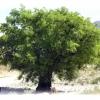Image: Women Walking to the Haat with their Produces.
This article seeks to dive deep into the life world of the adivasis through trope of Minor Forest Produces (MFP) and portray how these seasonal 'forest products' organize their lives and connects them to the larger circuits of national and global capital.
Amongst other things a large part of 'Life' in Bastar revolves around leaves, flowers, roots, fruits, tree saps and insects. Unlike our lives which revolves more around monetized exchange, people in Bastar organize their lives around what might be called an ethic of reciprocity. Animals, plants, birds and insects and humans draw from each other what they need. Each offer themselves to the other for the other's survival around the seasons.
The commonly occurring trees of the forests of North Bastar region such as Kusum, Sahjha, Mahua, Harra, Behra, Sihari, Tendu, Chind, Sal, Beeja and Sur along with their dependent fauna constitute a plethora of plant and animal species which have an intimate relationship with the lives of the forest dwelling communities such as the Gonds, Kalhars, Marars, Halbis, Durwas, Murias and Marias. Gonds and Murias also identify themselves as Koyaturs; Maria's draw their identity from their habitat i.e. the 'Mar' or the highlands and the forests.
Apart from timber which is largely used for construction of dwellings and firewood; leaves, flowers, fruits, seeds, tree saps, roots, stems, bark and even a few insects becomes a life line which sustains life within the forest. The state bureaucracy has historically classified such products as Minor Forest Produce or Non Timber Forest Produce (NTFP) as they see it as a secondary product with relatively lower value of exchange when compared to timber, but studies reflect that for over 75 percent of the total adivasi population across central and eastern India... mahua is a major cash crop (CFPF). They eat the flower, barter it for grain, and sell it for cash." (Jha & Vittalamurthy, 2018) again they also brew, drink, eat and offer mahua to their ancestral spirits to solemnize all their life rituals.

Image: Mahua at the local haat. Photo Credit: Arunpol Seal. (All the pictures in this essay belong to Arunpol Seal unless otherwise mentioned)
Tendu leaf, another Minor Forest Produce (MFP) is used to roll beedi. Adivasi's collect the leaf as part of their rights defined under 'Scheduled Tribes and Other Traditional Forest Dwellers Recognition of Forest Rights Act, 2006 (FRA)'. The collection rate of tendu leaf is approximately Rs.1,250 per Standard Bag or 50,000 leaves.
Apart from Mahua and Tendu leaf other 'produces' such as lac, beeja, sal leaf, tamarind, tussar cocoons, chironjee, amchur (dried mango), jamun (berries), futtu and Pihri (mushrooms) and raar (farkainscence) are also extremely important sources of income and livelihood. Alongside the financial value each of these entities have an elaborate cultural significance within the everyday of the adivasis.
Forest as Resource and Forest as a ‘Community’:
All life is a process of connection and interaction. Anybody or thing is the outcome of a process of connections (Colebrook, 2002).
The Forests as the bureaucracies see it, is a 'Noun'. A 'thing' with certain defining qualities. The forest is understood as a place where various plants, trees, animals, birds, insects have made their natural habitat. Administrators also see it as a habitat for human beings; human beings of a certain kind. Those who are considered to be at the margins of our civilization. The forest is largely seen as a whole. A whole with components i.e. the flora and the fauna. A whole which has a certain order and organization, an asset from which a spectrum of goods and resources can be acquired and which needs to be managed and protected by rules and laws. The perspectives may vary a little about the laws and who they protect the resource from! Who may have right over the resources? Whether it will be those who bring remittances to the nation and add to its wealth or whether it should belong to those who had lived within the 'forest’; but by and large civilization has seen the forest as a resource.
Consequently it has created its own set of hierarchies of the components that constitute the forest. Since civilizations identified forests as a resource, the hierarchies of its products too have been derived from their understanding of its 'value', which is essentially based on transaction and exchange. In other words, the hierarchies have been derived from the 'exchange value' of the produce that can be exchanged as commodities in the market. Based on this 'logic of economy' the forest gets commercially classified and managed. The economy of the forest provide the administrators the rationale of governing it. A rationale that identifies timber as a product of primary importance with the highest 'rate of exchange', hence greater 'exchange value' and the rest only becomes secondary to it. The rest of the 'forest' apart from timber gets classified as 'non' timber or minor forest produce.
Those who live within 'the forest' and consequently at the fringe of our 'civilization' although find it difficult to classify the forest based on its 'exchange' value; they depend heavily on the use of those 'produce' in their daily lives, often for sustenance. Such use of the 'produces' have often allowed them to have a far deeper understanding of the forest and the nature around them. For them the flowers, leaves, tree saps, molds, animals, birds and insects have greater value because these beings are not just life-less produces fit to be exchanged for money but rather 'living beings' that allow the human communities living in the forest to adapt to their environment (Robbins, 2018).
My interactions with the forest dwelling people of Uttar Bastar reveal that they consider the forest as (a) living beings, living together like a community. The living beings that constitute the forest are believed to have spirits, 'pens' and every spirit must remain happy and perform its duties for the well-being of the forest dwellers. Trees, river, mountains, animals all have spirits, which must communicate and participate in constituting the factors which will support life within the habitat.
Interestingly, even though their knowledge about the commercial value of the forest produce and their understanding of it as sustenance products do not exist as dyads; their views are not in opposition to the commercial logic of the civilized world. The forest dwelling adivasis of Uttar Bastar have learnt to adapt, negotiate and navigate between the two world views. For them both the economic and the non-economic matters! Studies reflect that for over 75 lakh Adivasis across central and eastern India... mahua is a major cash crop (Jha & Vittalamurthy, 2018). Collection of flowers is done on both revenue and forest lands, mostly by women and children. The estimated amount of mahua collected is 85,000 tons out of a potential 4,90,000 tons. Mahua collection provides employment to 28,600 people per year out of a potential of 1,63,000 people per year. On average, annual household consumption of fresh mahua flowers is 150 kg, which is worth Rs 750, and consumption of dried mahua flowers is 50 kg, which is worth Rs 750; whilst sales of flowers amount to 350 kg, which is worth Rs 3500. Thus, mahua brings benefits of about Rs 5000 to each family every year (CFPF). Mahua also gets consumed within the household, it is the most common brew, a snack, and also forms an essential part of the meals. Mahua is offered to their ancestral spirits to solemnize all their life rituals.
Tendu leaf, another Minor Forest Produce (MFP) is used to roll beedi. It is the financial lifeline of the forest dwellers of central India. Adivasi's collect the leaf as part of their rights defined under 'Scheduled Tribes and Other Traditional Forest Dwellers Recognition of Forest Rights Act, 2006 (FRA)'. The collection rate of tendu leaf is approximately Rs.1,250 per Standard Bag or 50,000 leaves in Madhya Pradesh, but this trade does not prevent them from collecting tendu fruits and offering them at Pandums as a symbol of respect to fruit that saves them when their crops fail.
Apart from Mahua and Tendu leaf other 'produces' such as lac, salbeeja, sal leaf, tamarind, tussar cocoons, chironjee, amchur (dried mango), jamun (berries), and raar (farkainscence) are also extremely important sources of income and livelihood but beyond those identities each of these entities have an elaborate significance within the everyday of the adivasis.
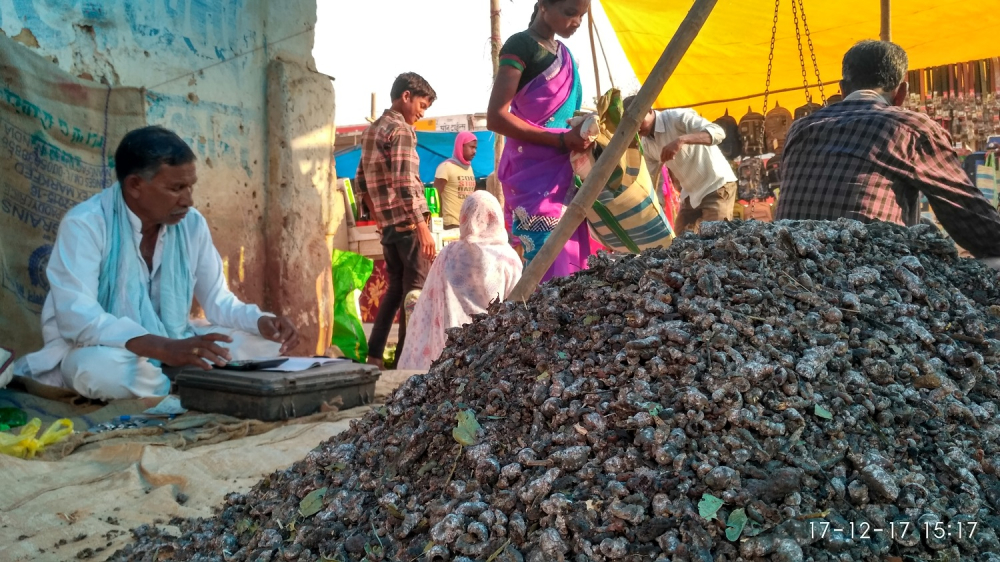
As I continued to collate the experiences of forest dwellers and also experienced the forest myself across the five seasons; I slowly realized that the forest does not remain the same place throughout the year. It also does not provide a constant flow of resources. During spring and early summer the forest is rife with mahua flowers and immature mango flowers, slowly as the flowers get pollinated and a majority of them start falling off the tree, the adivasis start collecting them. They do not touch them until the time of pollination is over. The pandum (a ritual) governs such behavior. As collection of mahua stops by the mid of April, the mangoes start appearing on the branches. Again, mangoes are not plucked until the time it is ripe and the seeds have matured enough to be dispersed. By the end of April and early May, the pandum of mango gets celebrated and mangoes are plucked. By mid of May the Tendu trees shootout a fresh flush of young leaves. The forest looks green and fresh, and within a couple of weeks throngs of women and men start gathering Tendu leaves. By the end of May leaves are dried, packed and sold and people start working on their respective agricultural plots- some dry mangoes, vegetables and tubers to fill their provisions for the upcoming monsoon. The rest remain busy working on their plots for the impending rains, which generally hits central India by the mid of June. As the first spell of showers come in the young and the old head out early morning into the deep woods collecting mushrooms, which pop up as the rains wash the forest. A popular belief amongst villagers is that, if it thunders while raining, then the next morning they will get lots of mushrooms.

The early spell of rains also signal the time to scrape off lac from Kusum and Palash trees.
There is no one forest. With the changing seasons various creepers, crawlers, vines, molds, animals, insects and birds appear and disappear from the forest. There is no fixed whole, although, it holds on to a territory, retaining its identity. The forest is what its components make of it. The forest is not a static, constant whole but a living dynamic entity, which keeps changing. Perhaps, such a paradox can be understood through deeper theories. Perhaps, one can conceptualize the forest as what Giles Deluze would call "an Assemblage, an arrangement of components, which does not reproduce one fixed predetermined result, yet appears to occupy a territory and retains an identity."
J Macgregor Wise, an eminent Deluzian scholar interprets the understanding of the concept of assemblage as "putting together", "arrangement", "laying out", "layout" or "fitting' (Cousin et al. 1990: 9-10 as appears in Ed Stivale 2005). It is important to note that (it)... is not a static term; it is not the arrangement or organization but the process of arranging, organizing, and fitting together. The term as it is used in Deleuze and Guattari's work is commonly translated as assemblage: that which is being assembled. An assemblage is not a set of predetermined parts (such as the pieces of a plastic model aero plane) that are then put together in order or into an already-conceived structure of a model aero plane). Nor is an assemblage a random collection of ‘Things’, since there is a sense that an assemblage is a whole of some sort that expresses some identity and claims a territory.
The extant traditional practices of the Koyaturs reflect an acknowledgement of the contingencies of the arrangement of life processes within the forest. Apart from the Pandums, other practices such as construction of house, making of bricks, making of agricultural equipment, societal arrangement, marriages, birth and death rituals reflect the changing, ever evolving aspect of the forest and also reflects an active agency on behalf of the community to protect this change; as it is this changing nature that indicates the life of the forest.
The seasons, the Rituals and the Forest
The forests of Bastar change with the seasons. Given that most of the trees are deciduous, leaves, flower and fruits appear and fall-off in various parts of the year. Different trees bear fruit in different seasons. The fruits and the flowers attract insects and animals and flourish of animals attract predators. Human communities of the forest prepare themselves across the year depending on these visible and experiential events. The year the bamboo plants flower, various communities organize hunting festivals to control the population of field rats. Not only are the field rats a popular game for young hunters but they also destroy grain banks of the population if their numbers are not checked. Similarly, as the Spring season grows and the Palash trees, Mahua and mustard shrubs start flowering, honey bees begin collecting honey, which attracts bears around the human settlement. Around the same time, bats eat the flowers of Mahua trees and also assist them in dispersal of pollen from the mahua trees. As Spring gives way to the early weeks of summer, the Mango and the Jamun trees start flowering, which brings in a fresh batch of bees and monkeys. Spring is a good time for small hunting games. Many communities organize hunting festivals during the Spring weeks as the forest comes alive with flowers. The early summers follow the spring, which also marks the ripening of the millets and ‘Cher-Chera’ is celebrated before the fresh harvest is consumed. People often sacrifice boars and cook boar with millets to celebrate Cher-Chera. During Cher Chera the spirits of the rivers, forest and the residing deities of the village are offered grains, sacrificial meat and Mahua. Apart from Cher-Chera, every season is celebrated with a Pandum and each Pandum has its own significance embedded within the context of the Changing nature of the forest.
As I lived through the seasons I prepared a schematic list of the popular forest products that came out of the forest:
|
Spring (Feb- March) |
Summer (Apr, May, June) |
Monsoon (July, August, September) |
Autumn (Oct- Nov) |
Winter (Dec, Jan, February) |
|
Mahua |
Tendu Patta |
Tori |
Rangini Lac |
Kusumi Lac |
|
Chind sap (Fishtail Palm sap) |
Imli |
Kusum beej |
Chirota |
|
|
Fishtail palm Kernel |
Chironjee |
Pemdana |
||
|
Raar |
Sarai Patta |
Bamboo shoots |
Raar |
|
|
Beeja Seeds |
Aam |
Koriya Patta |
||
|
Sal/ Sarai Seeds |
Honey |
Putu & Pihri (Mushrooms) |
||
|
Kusum fruit |
Many of these forest products are an integral part of the life of the adivasi communities, while others are generally collected for an external market. Mahua, Tori, Chind Sap, Kusum Fruit, , Sarai (Sal) Leaves, Sihari leaves, Koriya leaves, bamboo shoots, Putu and Pihri (mushrooms) and chirota are consumed by the community; Lac, Amachur, Imli, Honey, Sal seeds, Beeja seeds and Chironjee are primarily collected for the external market. Mahua and Raar (tree sap of sarai/sal used for incense) are collected for both, external market as well as daily use. Mahua, particularly has an interesting journey as a forest product. It dwells in both the sphere of the community as an essential product and also as a commodity in sphere of the market. It briefly enters the circuit of market and capital during the spring season, when it gets collected in abundance; and gets re-sold to the adivasis during late autumn and winter when demand of Mahua rises with the festivities. At this juncture it makes a re-entry into the life of the adivasis.
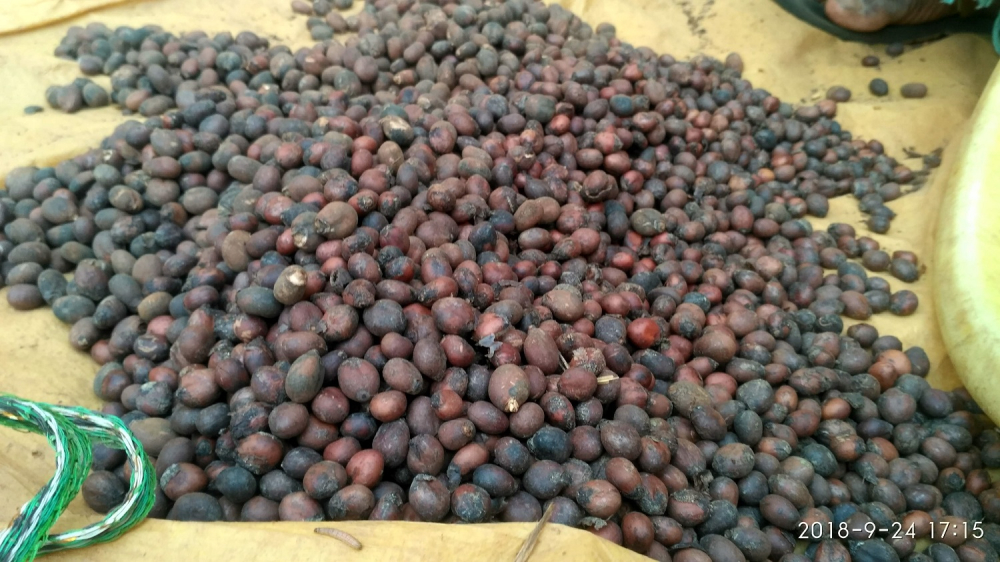
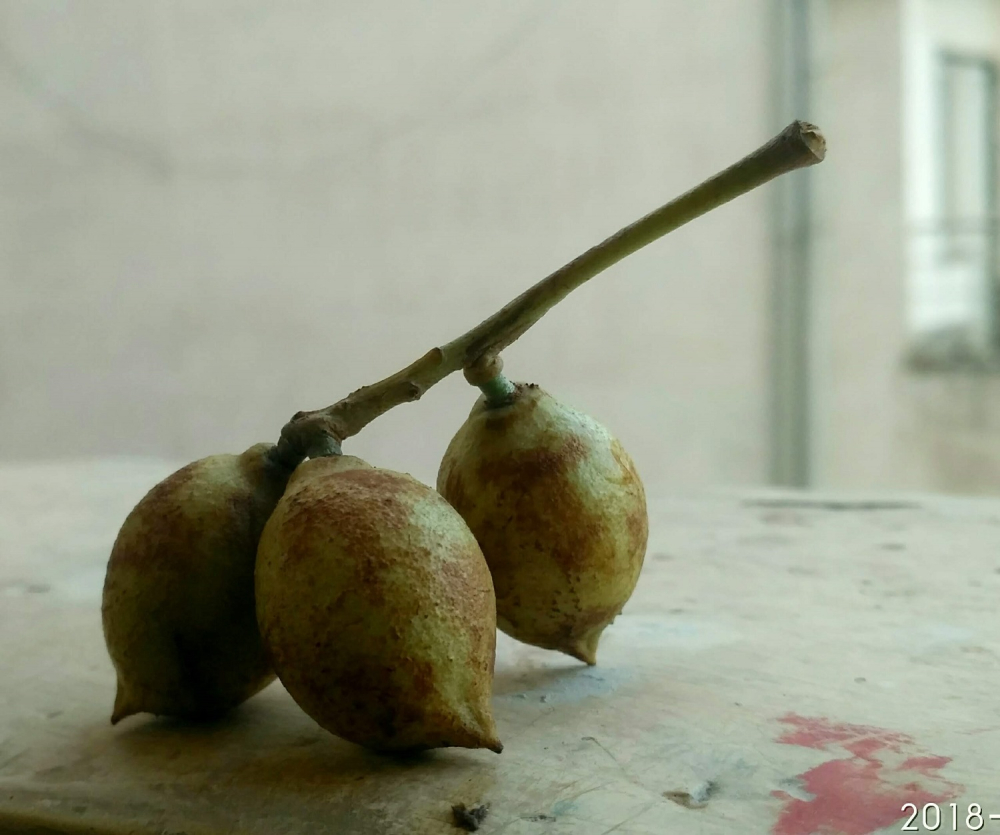
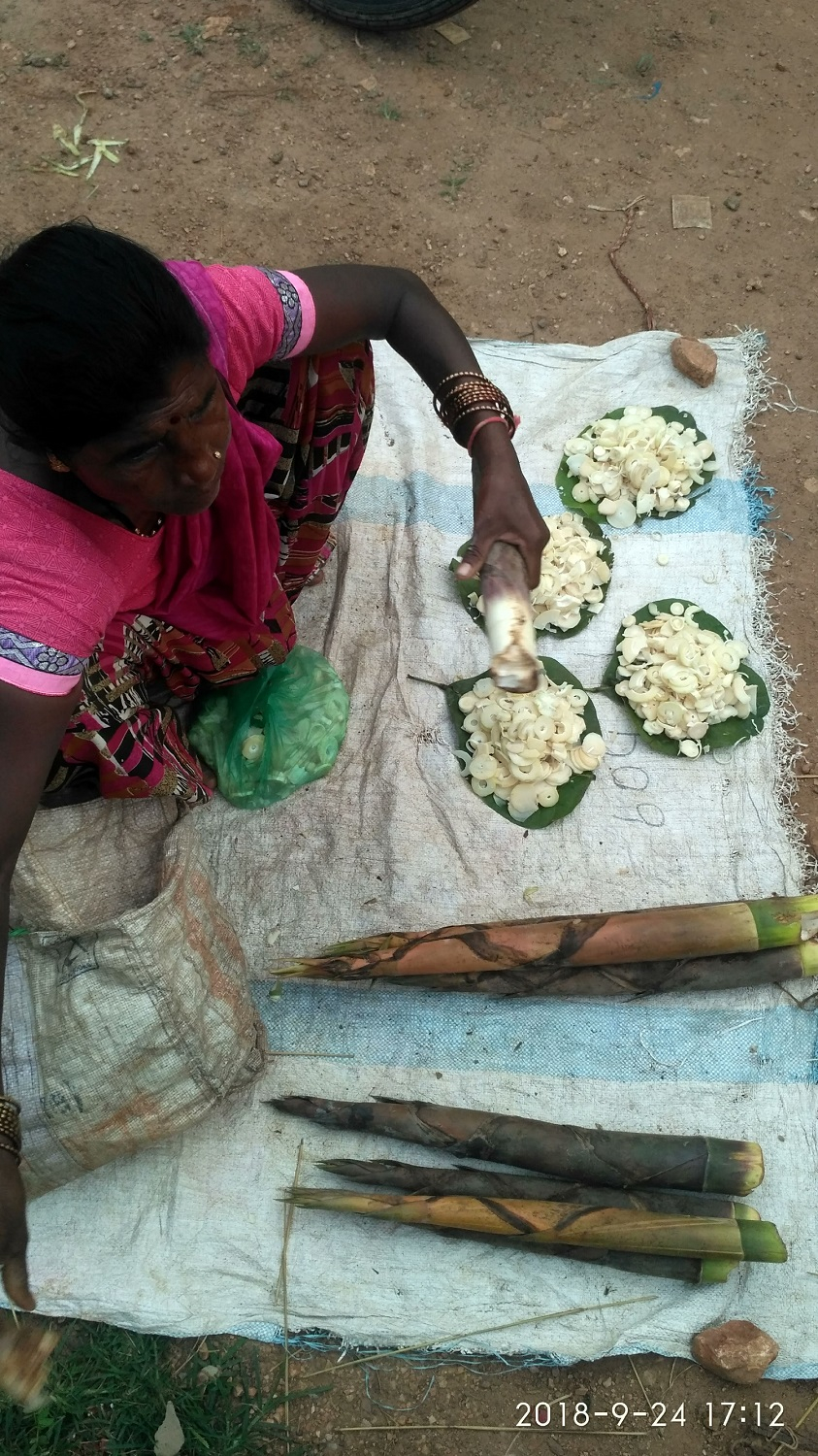
Image: Bamboo Shoot at the local haat

The Adivasi society and the Forest:
As I stayed with the forest communities, I realized that the structure of the adivasi society reflects its symbiotic relationship with the forest and it flora and fauna. I learnt about the connection of the societal structure and its relationships with the forests through a series of conversations that I had with the ritual head of a village in northern Bastar. Living life within the village space also informed me adequately about the unique construction of the adivasi society, especially of the Gonds. A few rituals, which I attended facilitated conditions which allowed me to learn, ask questions and understand what we may call the socio-ecological relations.
"Whatever we collect from the forest and whatever we produce on our lands we offer them first to our ancestors, our deos! They all live with us..."
Said Singh Rai, the gaita of Banoli. It was 2nd February 2018 and Banoli, a sleepy Gond village in Bhanupratappur Block of Uttar Bastar, Kanker had a quite a few visitors from the neighboring villages. Singh Rai accompanied me and took me across the vast expanse of the paddy fields towards the hills that border Banoli. At the base of the hill was a small house hidden inside a grove of Sahjha, Kusum, Peepal and Mahua trees. As we approached the Grove, Singh rai asked me to take off my shoes. He pointed to the hut and said that it is the Raur (residence) of the deo of Banoli, his name is Maran marri; the eldest son of their great ancestor Lingo pen. As I entered the grove with my bare feet, I noticed a couple of men worshiping the Shajha tree that stood beside the raur. They had placed millets, rice grains, lemons and had sacrificed a couple of chickens to the tree. I silently sat through the rituals that went on for about an hour. Singh Rai explained each of the rituals and their significance. He explained how the millets are ripe, how the mahua flowers have just appeared on the branches of the mahua tree, the bees are busy collecting honey and it was time for them to offer the millets to their ancestors. Ancestors who have not left them or their village.
He pointed at the Shajha tree which was being worshipped and said how mahua trees won’t survive without Shajha hence it is considered to be essential for life to sustain and Mahua signifies life it-self. Singh rai said that they call themselves 'Koyaturs'. Mahua is called 'Koya' in Gondi and 'tur' means people. He went on; shajha and mahua are totemic trees. They symbolize the species which a certain group of Gonds (differentiated by their surnames) would protect. I learnt that the groups are referred to as gotras. Each gotra had the duty to save guard/protect at least three specified species: one bird, one animal and one plant so that while others from the community would consume them some would also work to protect them.
Alongside, Singh Rai that morning a few other important men from the Gond Samaj were present. I met Mangu Ram Darro the Manjhi of Maran Marri. Mangu Ram Darro explained how Gonds are divided in 750 gotras, a system of classification and social construction to optimize resource usage. Each gotra is entrusted to save three species, hence it is claimed almost all the species that reside in the forests of Bastar are collectively conserved and preserved by Gonds. The ethic of saving such totemic species are so strong amongst Gonds that they neither harm or hunt these species nor do they give away the location of these species even if someone close wants to hunt or harm them. He mentioned that it would maintain the balance and allow regulation of consumption; preventing an exploitation of certain animals, plants, insects or birds if the whole community forages, hunts and gathers them. The gotras till date maintain their customs. The Mandavi’s (a surname signifying a gotra) do not kill or consume goats. Similarly, the Anchla’s (yet another surname and another gotra) would not kill snakes or eat them, and would instead protect them. I learnt from another siyan called Ram Nareti from Hanpatri that the Gotras were created by their ancestor, Lingo who helped the adivasi’s to structure their community within the forests of North Bastar. He devised such a scheme in order to protect both his clan and also the plants and animals of the forest, which were the domain of their ancestors. Verrier Elwin and Grigson called the Gond people of North Bastar as the "clan of the Lingo"; a much worshipped forefather who is worshipped till today amongst the Gonds and is attributed with most of the codes of living and conducting oneself within the Koyatur Samaj in general and with respect to their forested habitat in particular.
The Forest and the Market:
On a designated day of a week every panchayat holds a haat. Traders from across the region (north Bastar) comes to these haats. Villagers from the surrounding villages of the panchayat comes down to the haats to buy and sell goods. In general villagers from the forest villages carry their forest produces such as Lac, Amachur, Imli, Honey, Sal seeds, Beeja seeds, Chironjee and Mahua.
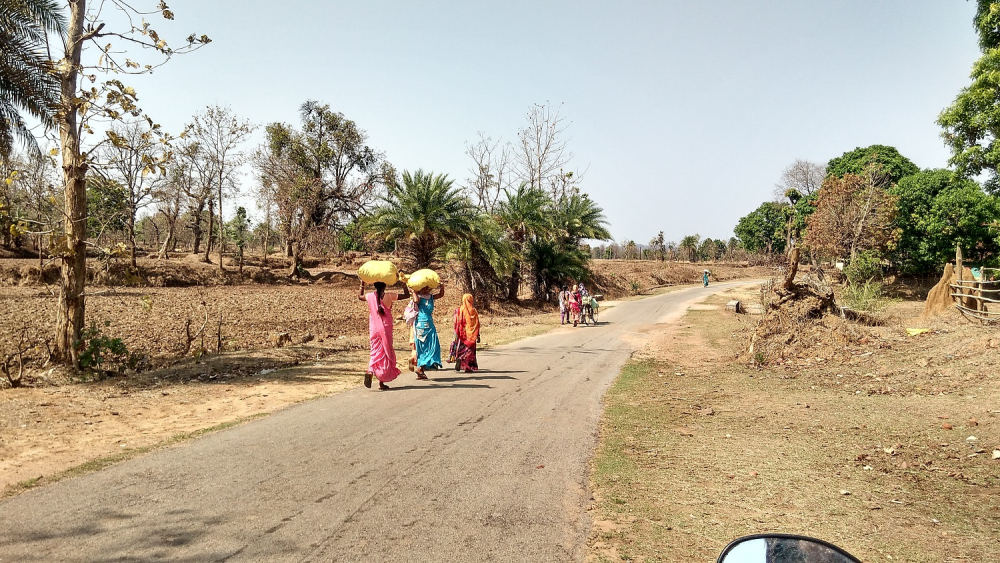
The traders who buy and aggregate forest produces mostly sit on the outer margins of the haat, capitalizing on the approaching women who carry their goods over their heads, traders lure them with their prices, weighs the produce quickly so that the seller can hardly verify the weight for, which she gets paid in cash.

Even before the groups of women who carry their produce could have an assessment of the market prices they end up selling their goods, often getting cheated by the thrifty traders. After selling they generally proceed to the center of the haat to buy salt, spices, stitched clothing, tobacco and occasionally oil and soaps before they return to their villages.

The local haats are generally run by traders from the roadside villages or road side towns. In general they are non adivasi settlers from Uttar Pradesh, Bihar, Rajasthan and Punjab. Increasingly these functions are also being taken over by the emerging elite from the Sahoo community as well.
These local traders are tied to larger traders who own large godowns and cold storages. Some local traders also own fleets of trucks and control the transportation around the areas. Most of the traders in Uttar Bastar Kanker district are from the Jain community. Some of them are old Sindhi and Marwari trading families who had settled in the relatively bigger towns of Bastar. These trading communities own most of the properties in the towns of Uttar Bastar such as Bhanupratappur, Sambalpur, Kanker, Charama and Narharpur. They maintain their control over smaller traders operating in the local haats through a payment of advance cash, which the smaller traders take as advance to buy the forest produces from the villages; in turn they come and sell the aggregated produce to the ‘seth’ or the bigger trader in Sambalpur, Bhanuprattapur or Kanker.
The ‘Seths’ hoard up hundreds of quintals of such forest produce and opens their stocks based on their speculations of market demand. As they stockpile they control the flow of the commodities to refinery and factory owners and with the complete control over transportation they earn a large profit through big business deals. Most of the aggregators of NTFP are connected to even larger traders, refinery owners and Factory owners of Dhamtari and Raipur. Dhamtari and Raipur are connected to Bastar through National Highway 30 via Kanker and Charama. The NH30 along with other State Highway road networks provide the necessary infrastructure to facilitate a big scale trade of NTFP across Southern Chhattisgarh. The scale of this trade can be understood as all through the Highway corridors the Forest Department have Gates which regulate and inspect the flow of NTFP and also collects duty from such trade. The Forest Department also plays the role of an important stakeholder in the trading mechanism directly as they maintain monopoly of business over certain commodities such as Timber, Tendu leaves and a category of forest herbs classified as ‘Medicinal Herbs’.
Apart from Tendu and Timber the most high value product that comes out of the forest is Lac . A resin, which is secreted by insects hosted by Kusum, Ber and Palash trees. Kusum and Ber can host Kusmi Lac insect and the Palash tree can host Ragini Lac insect.
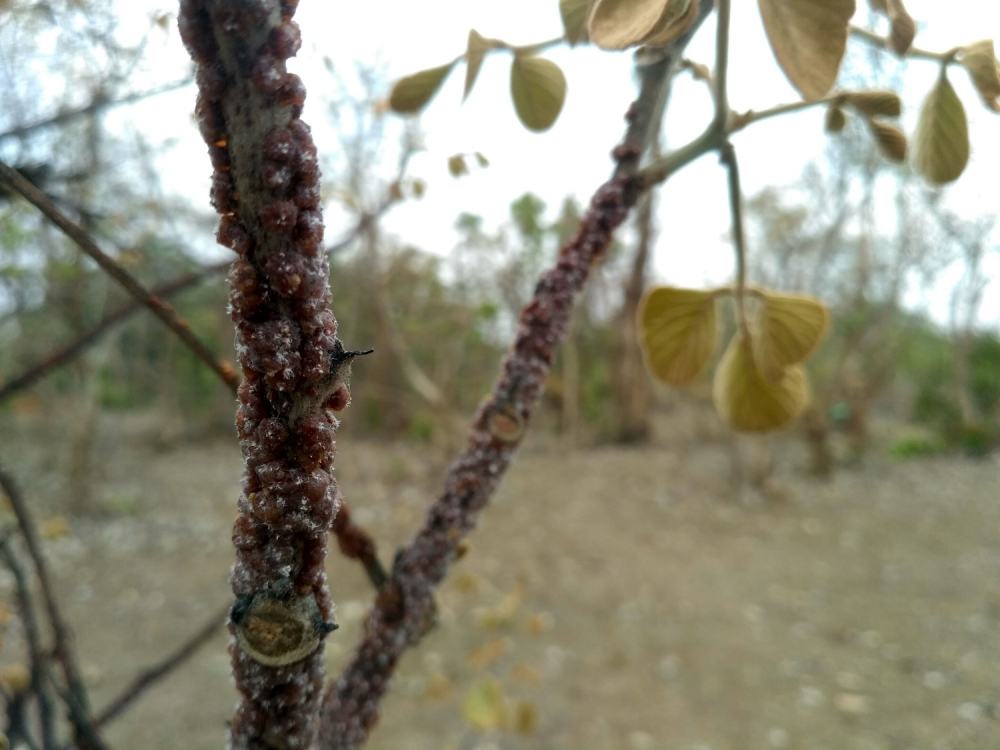
Both these variety of insects secrete a resin, which forms thick encrustations atleast twice a year. A relatively old Kusum tree can yield upto 70-100 Kgs of Scrapped lac every season. With a relatively high abundance of Kusum and Palash trees across northern Chhattisgarh, Lac is one of the major produces of the district. Uttar Bastar Kanker ranks as the 10th largest producers of Lac as per the report of IINRG. The annual output of Lac in 2013-14 from Kanker district was over 735 tonnes. A Kilogram of scrapped Lac would fetch a rearer somewhere around 150-300 Rupees. The prices of Lac fluctuate a lot as they are subject to speculations of the international markets as India exports over 95 percent of lac, which it produces.
Although Forest Produces form what we call the life line of the adivasi, they seldom have any control over its exchange value. As a community they have kept away from the promises of the circuits of capital and, hence they have not tried to exploit them. For them Forest produces are necessities, which needs, care protection and empathetic use. They often address to these fruits, roots, tree saps, flower as manifestations of their ancestors, adding a spiritual and ecological value to these elements of nature a spiritual and ecological value; associating it with a life within nature. However, the adivasi communities have started their transition too. A class of elite has emerged out of the forest. They are moving towards the roadside villages and towns and are slowly getting induced within the circuits of capital. While most fall through the gaps and are stranded as they become rootless with lure of the urban, some of them also manage to keep afloat and starts mimicking their oppressors i.e the settler populations who control, trade, commerce and administration. The Development Organizations and Foreign funded Civil Society is also in a hurry to induce these populations into the logic of Modernity, Capital and Development. As it appears now more and more of what comes out of the forest would become commodities. With vanishing populations from within, the forest customs and necessities will also change. Perhaps, we are not far from the era when leaf cups would no longer be made, people might buy their Mahua off the counters and the adivasi will visit the corner store for their daily ration, instead of freely gathering their needs from their habitat.
List of trees with (Scientific Names):
Kusum- Carthamus tinctorius
Sahjha- Terminalia tomentosa
Mahua- Maduca indica
Harra- Terminalia chebula
Behra- Terminalia bellerica
Tendu- Diospyrus melanoxylon
Chind- Phonenix Dactylifera
Sur- Caryota (Genus) Fishtail Palm
Koriya- Holarrhena hantidysenerica
(Shukla and Singh, 2014)
Map of Forest Produce Markets and Haats across Northern Bastar
References:
Jim, Robbins.2018. "Native Knowledge: What Ecologists Are Learning from Indigeneous People". Yale Environment 360, April 26, 2018.
Monica, Jha & Sriram Vittalamurthy. 2018. "Mahua Story". Fountain Ink, May 31, 2018.
Mahandran, V., Murugan ,C.M, Marimuthu, G. & Nathan, P.T. 2018. "Seed Dispersal of a Tropical deciduos Mahua Tree, Mahua Latifolia exhibiting bat fruit syndrome by peteropodid bats. Global Ecology and Conservation, 14, 2018.
Latour, B. 2014. "Agency at the time of the Anthropocene".New Literary History Vol. 45, pp. 1-18, 2014.
Shukla, Ashok. K. & Singh, Annu. Diversity of Forest Tree in the Forest of Sarguja District, Chhattisgarh, India in International Journal of Science and Research (IJSR) ISSN (Online): 2319-7064, 2014.
NTFP Enterprise and Forest Governance Andhra Pradesh, Madhya Pradesh and Orrisa: Mahua, Centre for People’s Forestry, ISBN 97881906691 7-7.
Stivale, Charles J., ed. Gilles Deleuze: Key Concepts. McGill-Queen's University Press, 2005. http://www.jstor.org/stable/j.cttq486p.
This content has been created as part of a project commissioned by the Directorate of Culture and Archaeology, Government of Chhattisgarh, to document the cultural and natural heritage of the state of Chhattisgarh.











